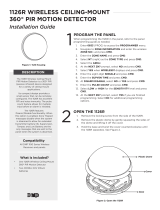Digital Monitoring Products 1183-135F Wireless Heat Detector Guide d'installation
- Catégorie
- Protection contre le feu
- Taper
- Guide d'installation
Ce manuel convient également à

1183 SERIES WIRELESS HEAT DETECTOR
Installation Guide
DESCRIPTION
The 1183 Series is available in two
models: 1183-135F and 1183-135R.
The 1183-135F is a fixed temperature
detector that reacts to heat by
responding to the fixed 135°
temperature setting. When
activated, an alarm is sent to
the control panel. The 1183-135F
model has a black dot on the heat
collector fin for identification.
The 1183-135R model is a
combination rate-of-rise and fixed
temperature detector that detects
heat quickly by responding to a
rapid temperature increase or a
fixed 135 ° temperature setting.
The element responds to a rapid
rise in temperature and sends an
alarm to the control panel when the
ceiling temperature increases at a
minimum rate of 15 ° F per minute.
An alarm is also sent to the panel if
the ceiling temperature reaches the
fixed 135 ° setting if the rate-of-rise
is not exceeded.
Compatibility
• All DMP 1100 Series Wireless
Receivers and Panels
What is Included?
• One 1183-135F or one 1183-135R
Heat Detector with DMP wireless
transmitter installed
• One 3V lithium CR123A battery
• Hardware pack
1PROGRAM THE TRANSMITTER
IN THE PANEL
1. Locate and record the detector serial number. This number
is required during programming.
2. Enter 6653 (PROG) at the keypad to enter the
PROGRAMMER menu.
3. Press CMD until ZONE INFORMATION displays. Press a
select key or area to enter the menu.
4. At ZONE NO:, enter the zone number.
5. At ZONE NAME, enter the zone name.
6. At ZONE TYPE, select FI (fire).
7. At NEXT ZONE?, select NO.
8. At SERIAL NUMBER, enter the eight-digit SERIAL NO found
on the device and press CMD.
9. At SUPVSN TIME, enter 3 and press CMD.
10. At BELL OPTIONS, press CMD until BELL OPTIONS displays,
and then press a select key or area.
11. At FIRE BELL ACTION FIRE TYPE:, select T (temporal) as
the action type.
12. Continue to program the zone as directed in the panel
programming guide.
Note: When a receiver is installed, powered up, or the panel is
reset, the supervision time for transmitters is reset. If the
receiver has been powered down for more than one hour,
wireless transmitters may take up to an additional hour to send
a supervision message unless tripped, tampered, or powered
up. This operation extends battery life for transmitters. A
missing message may display on the keypad until the
transmitter sends a supervision message.
Transmitted Signal Outputs
The heat detector provides the signals listed in the table:
Signal Keypad Display
Alarm ALARM
Low battery LO BAT
Detector head removed TROUBLE
Figure 1: 1183 Series Wireless
Heat Detector
WARNING: 1183 Series Heat Detectors are single use
detectors. Do not test them with a heat source.

2 1183 INSTALLATION GUIDE | DIGITAL MONITORING PRODUCTS
3Install the transmitter away from large metal objects because metal
surfaces impairs performance. The 1183 Series transmitters allow one
person to confirm communication with the receiver while the cover is
removed
The 1183 Series Wireless Heat Detector provides a Survey LED
capability to allow one person to confirm communication with
the wireless receiver or panel while the cover is removed.
1. With the battery cover removed, hold the transmitter in
the exact desired location.
2. Press the survey button to send data to the panel and
determine if communication is confirmed or faulty.
Confirmed: If communication is confirmed, for each
press or release of the tamper switch, the LED blinks
immediately on and immediately o. Repeat this test
to confirm five separate consecutive LED blinks. Any
indication otherwise means proper communication
has not been established.
Faulty: If communication is faulty, the LED remains on for
about 8 seconds or flashes multiple times in quick
succession. Relocate the detector or receiver until the LED
confirms clear communication.
SELECT A LOCATION
Battery Compartment
Battery Cover
Battery
Figure 2: Battery Compartment
INSTALL THE BATTERY
2Observe polarity when installing the battery. Use only 3.0V lithium batteries, DMP Model CR123-FIRE or
Panasonic Model CR123A.
Note: When setting up a wireless system, it is recommended to program zones and connect the receiver
before installing batteries in the transmitters.
1. Slide the battery compartment cover away from the detector to unsnap it and lift it o. See Figure 2.
2. If replacing the battery, remove the old battery and dispose of them properly.
3. Observing correct polarity, insert the new 3V lithium battery into the battery compartment and replace
the cover. Use only new batteries when replacing old ones.
4. Reattach the detector to the mounting base. See Attaching and Removing the Detector.
5. Test the detector. See Test the Detector Alarm.
Caution: Properly dispose of used batteries. Do not recharge, disassemble, heat above 212 ° F (100°C),
or incinerate. Risk of fire, explosion, and burns.
Survey Button
Survey LED
SURVEY
Figure 3: Survey Button

1183 INSTALLATION GUIDE | DIGITAL MONITORING PRODUCTS 3
MOUNT THE DETECTOR
When setting up a wireless system, it is recommended to
program zones and connect the wireless receiver before
installing batteries in the transmitters.
Install the Mounting Base
Using the two screws provided, mount the base in the
location previously surveyed for proper communication.
Attach the Detector
1. Using the alignment notch on the lip of the
mounting base as a guide, align the detector with
the alignment tabs.
2. Insert the detector into the mounting base and
turn clockwise approximately 15 degrees. It should
snap firmly into place.
Note: To remove the detector from the mounting
base, grasp the detector and turn it
counterclockwise approximately 15 degrees. The
detector should snap o of the mounting base.
See Figure 4.
4
5TEST THE DETECTOR ALARM
1. To test the detector alarm, enable Walk Test operation on the control panel. If the system is monitored,
the system sends a System Test Begin report (System message S66) to the central station.
To conduct the Walk Test, reset the control panel. From the keypad, enter the code 8144. The keypad
displays WALK TEST. Refer to the panel programming guide for complete information on Walk Test
operation.
2. For the XTL Series panels or XT30/XT50 Series panels, select STD (Standard Walk Test). For the
XR150/XR550 Series panels, select FI (Fire zones). A sensor reset occurs after each detector tested.
3. Remove the heat detector from the mounting base. See Attaching and Removing the Detector.
Carefully short the two terminals (screw heads) momentarily to send an alarm signal to the control
panel. Verify that the walk test trip counter increments to indicate a successful test. Once testing is
completed, install the detector back onto the mounting base. Shorting the terminals does not aect
the standard operation of the detector.
4. Select END to stop the Walk Test. When the Walk Test ends or a 20-minute time-out expires, a final
Sensor Reset occurs. The System Test End message (System message S67) is sent to the central
station along with verify and fail messages for each zone under test. Faulted zones then display on the
keypad.
Note: The control panel alarm and all auxiliary functions should be verified for a complete test of the
system. See the panel programming guide for additional information.
Alignment
Tabs
Alignment
Tabs
Mounting Holes
Alignment
Notch
Figure 4: Mounting Base
General Location Guidelines
In addition to NFPA 72, use the following location guidelines to optimize performance and reduce the chance
of false alarms from the detector:
• Locate ceiling-mounted detectors in the center of a room or hallway at least 4 inches from any walls or
partitions
• Locate wall-mounted heat detectors so the top of the detector is 4 to 12 inches below the ceiling
• Mount the detector on a firm permanent surface
• Locate the detector in environmentally controlled areas where the temperature does not exceed 100
°
F
(37.8 ° C).
• In rooms with sloped, peaked, or gabled ceilings, locate detectors 3 feet (.9 meters) down or away from
the highest point of the ceiling
• When mounting to suspended ceiling tile, the tile must be secured with the appropriate fastener to
prevent tile removal
WARNING: 1183 Series Heat Detectors are single use detectors. Do not test them with a heat source.

Designed, engineered, and
manufactured in Springfield, MO
using U.S. and global components.
LT-1186 1.02 20461
1183 SERIES WIRELESS
HEAT DETECTOR
Specifications
Frequency Range 905 - 924 MHz
Battery Life 2 years
Dimensions 5.8” x 2.2”
(14.3 cm x 6.1 cm)
Heat Alarm Specifications:
Rate-of-Rise 15 ° F/min > 105 ° F
(8.3 ° C/min > 40.6 ° C)
Fixed 135 ° F ± 5 ° F
(57.2 ° C ± 2.8 ° C)
Patents
U.S. Patent No. 7,239,236
Certifications
California State Fire Marshal (CSFM)
FCC Part 15 Registration ID: CCKPC0134
New York City Fire Department (#6167)
Industry Canada Registration ID: 5251A-PC0134
Underwriters Laboratory (UL) Listed
ANSI/UL 521 Heat Detectors for Fire Protective Signaling Systems
INTRUSION • FIRE • ACCESS • NETWORKS
2500 North Partnership Boulevard
Springfield, Missouri 65803-8877
800.641.4282 | DMP.com
FCC INFORMATION
This device complies with Part 15 of the FCC Rules. Operation is subject to
the following two conditions:
1. This device may not cause harmful interference, and
2. this device must accept any interference received, including
interference that may cause undesired operation.
The antenna used for this transmitter must be installed to provide a separation distance of at least 20 cm (7.874 in.) from all persons. It
must not be located or operated in conjunction with any other antenna or transmitter.
Changes or modifications made by the user and not expressly approved by the party responsible for compliance could void the user’s
authority to operate the equipment.
Note: This equipment has been tested and found to comply with the limits for a Class B digital device, pursuant to part 15 of the
FCC Rules. These limits are designed to provide reasonable protection against harmful interference in a residential installation.
This equipment generates, uses and can radiate radio frequency energy and, if not installed and used in accordance with the
instructions, may cause harmful interference to radio communications. However, there is no guarantee that interference will not
occur in a particular installation. If this equipment does cause harmful interference to radio or television reception, which can be
determined by turning the equipment o and on, the user is encouraged to try to correct the interference by one or more of the
following measures:
1. Reorient or relocate the receiving antenna.
2. Increase the separation between the equipment and receiver.
3. Connect the equipment into an outlet on a circuit dierent from that to which the receiver is connected.
4. Consult the dealer or an experienced radio/TV technician for help.
INDUSTRY CANADA INFORMATION
This device complies with Industry Canada Licence-exempt RSS standards. Operation is subject to the following two conditions:
1. This device may not cause interference, and
2. this device must accept any interference, including interference that may cause undesired operation of the device.
This system has been evaluated for RF Exposure per RSS-102 and is in compliance with the limits specified by Health Canada Safety
Code 6. The system must be installed at a minimum separation distance from the antenna to a general bystander of 7.87 inches (20 cm)
to maintain compliance with the General Population limits.
Le présent appareil est conforme aux CNR d’Industrie Canada applicables aux appareils radio exempts de licence. L’exploitation est
autorisée aux deux conditions suivantes:
1. l’appareil ne doit pas produire de brouillage, et
2. l’utilisateur de l’appareil doit accepter tout brouillage radioélectrique subi, même si le brouillage est susceptible d’en
compromettre le fonctionnement.
L’exposition aux radiofréquences de ce système a été évaluée selon la norme RSS-102 et est jugée conforme aux limites établies par le
Code de sécurité 6 de Santé Canada. Le système doit être installé à une distance minimale de 7.87 pouces (20 cm) séparant l’antenne
d’une personne présente en conformité avec les limites permises d’exposition du grand public.
ADDITIONAL INFORMATION
Heat Collector Fin
The 1183 Series heat detectors use a heat collector fin (See Figure 5) to
detect temperature changes. The fin is spring loaded and sensitive to
handling. Do not set the detector on the collector fin or put pressure on the
fin while handling as this could cause damage to the internal operation.
Mounting Base
Alignment Notch
Tamper Post
Detector Cover
Battery Compartment
Heat Collector Fin
Figure 5: Heat Detector Exploded View
-
 1
1
-
 2
2
-
 3
3
-
 4
4
Digital Monitoring Products 1183-135F Wireless Heat Detector Guide d'installation
- Catégorie
- Protection contre le feu
- Taper
- Guide d'installation
- Ce manuel convient également à
dans d''autres langues
Documents connexes
Autres documents
-
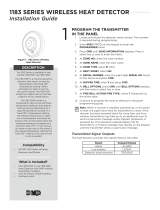 DMP Electronics 1183 Series Guide d'installation
DMP Electronics 1183 Series Guide d'installation
-
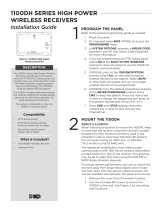 DMP Electronics 1100DH Series Guide d'installation
DMP Electronics 1100DH Series Guide d'installation
-
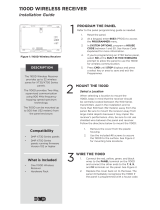 DMP Electronics 1100d Guide d'installation
DMP Electronics 1100d Guide d'installation
-
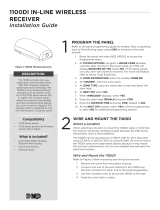 DMP Electronics 1100DI Guide d'installation
DMP Electronics 1100DI Guide d'installation
-
AJAX 9NA MotionProtect Plus Pet Immune Motion Detector Mode d'emploi
-
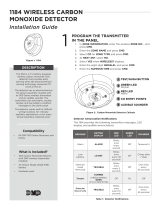 DMP 1184 Guide d'installation
DMP 1184 Guide d'installation
-
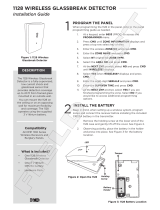 DMP Electronics 1128 Guide d'installation
DMP Electronics 1128 Guide d'installation
-
Apollo 51000-305 Guide d'installation
-
QOLSYS QS5210-840 Guide d'installation





